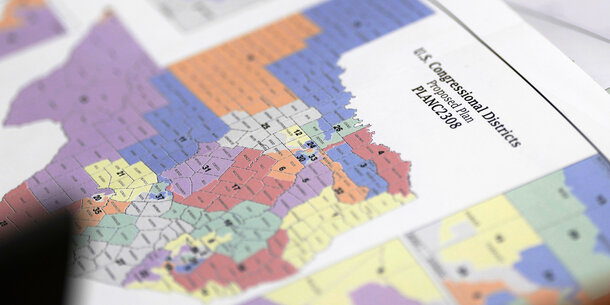Last week, the American Statistical Association released its initial report evaluating the quality of the 2020 Census.
The report made headlines with its conclusions that there’s “no evidence” either that political interference influenced the final count, or that the numbers aren’t good enough to use for their constitutional purpose of splitting up seats in the U.S. House of Representatives. But the report also shed light on how the bureau went about its once-a-decade head count in the face of the Covid-19 pandemic. Those efforts included a variety of counting methods beyond collecting forms and knocking on doors. Let’s take a deeper look at those methods and why they’re crucial to any plan for a full, fair, and accurate count.
How did the Census Bureau try to count the whole country in 2020?
The bureau primarily counted people by collecting answers sent by mail, on the internet, or over the phone. If a household didn’t respond by late summer, the bureau sent a census worker to knock on their door — up to six times. Some households didn’t answer, so the bureau asked other people who might know about them, such as neighbors, landlords, or real estate agents (sources known as “proxies”). Together, these methods helped the bureau account for 95.5 percent of all occupied housing units in the country.
The bureau counted another 3.8 percent of occupied housing units using information it found in administrative records either from the federal government or the states. Those records included previous census forms, IRS tax returns, and home-ownership documents. The bureau tested this procedure widely prior to 2020, and it helped alleviate the heavy workload on census takers by allowing them to knock on some doors only once.
To count the remaining 0.7 percent of occupied households, the bureau turned to a data-processing technique called imputation. Imputation fills in gaps by using statistics to predict what the missing information is. The bureau bases its statistical guesses on data it already has about a household or similar households. The bureau can use imputation to figure out how many people are in a household (known as “count imputation”) or to fill in missing demographics about people, such as race or age (known as “characteristic imputation”). This method is statistically sound, globally accepted by social scientists, demographers, and statistical researchers, and has been part of the bureau’s toolkit for the census since the 1960s.
Why are administrative records and imputation so important?
As we’ve seen, administrative records and imputation typically count only a small percentage of the total population. But that small percentage is crucial both to increasing the accuracy of the count and to fighting the systemic undercounts that have led to unequal representation and lack of funding for historically undercounted populations, particularly communities of color.
No census has ever produced a perfect count. And while the jury is still out on the quality of all 2020 Census data sets, it is unlikely that this census was perfect, either. Indeed, it may still contain significant undercounts and other data inaccuracies. Regardless, it is essential that the Census Bureau attempt to produce the most accurate enumeration possible. The bureau cannot just ignore households it knows people live in — that’s the opposite of what it means to take a population census. Imputation and administrative records help the bureau account for people whom it would otherwise miss or skip, and thus get closer to fulfilling its basic, constitutional responsibility to count everyone.
Moreover, the households the bureau fails to reach aren’t a representative cross-sample of the country. So, these gap-filling techniques aren’t just about accuracy, they’re about equity — trying to ensure all groups of people are fairly represented in the final numbers.
Studies of past censuses have clearly shown that certain racial and ethnic minorities face persistent undercounts and are undercounted at rates higher than their white counterparts. The 2000 and 2010 Censuses, for example, both undercounted the Black population by about 2 percent while overcounting the white population. The potential barriers to census participation vary by community, ranging from language barriers and housing instability to fears that the government will use census data for harmful purposes.
The bureau makes efforts to overcome these barriers. For example, the bureau now partners with local governments and civil society organizations to support Get Out the Count campaigns that boost census participation at the grassroots level. But many of those efforts, like the bureau’s massive door knocking operation, can be extremely expensive and time-consuming. And no matter what the bureau does, there will always be people it fails to find or households that refuse to open their doors to enumerators.
High-quality administrative records and imputation can help fill in the gaps. These methods provide a clearer, more accurate picture of the population. Were the bureau to stop using them, or to turn to less statistically sound methods of enumeration, the census would simply miss more people, and minority populations would disproportionately feel the harmful effects. That would be a significant blow to the accuracy, equity, and legitimacy of the final count.
How long has the Census Bureau been using administrative records and imputation to count people?
The bureau has a long track record of using administrative records and imputation to fill in the count. Each decade, the bureau has refined these methods to include more complex procedures, handle larger datasets, and streamline processing through computers and automation.
As reducing racially differential undercounts became central to the bureau’s work, the 1980 Census used administrative records to identify members of minority communities it had missed. In the 1990 and 2000 Censuses, the bureau counted people on parole or probation as well as military and federal employees living overseas using administrative records. These practices continue today as the 2020 Census used administrative records both to identify occupied households that needed to be counted and to supplement information for households that did not respond.
Imputation also has a long pedigree. The 1960 Census was the first to use a modern version of imputation. The procedure filled in the count and characteristics of missing households using census data from neighboring housing units, ultimately imputing 0.5 percent of the total count. The bureau continued to use imputation at relatively low levels through the following decades: 0.44 percent of the total resident population in 1970, 0.34 percent in 1980, and, in 1990, 0.02 percent (53,600 responses), the lowest number ever recorded.
The 2000 Census used imputation at a somewhat higher level. While the bureau originally aimed to reduce the census’s rising cost by developing data for non-responding households using a sampled subset of the population, it was forced to change plans after the Supreme Court barred it from doing so. As a result, the 2000 Census relied heavily on imputation to supplement its door knocking efforts, eventually adding about 1.2 million people (0.43 percent) to the total count. The National Research Council concluded that had the bureau not used imputation, it would “undoubtedly have underestimated the true number of household residents.”
The 2010 Census had similar count imputation rates as 2000, with 1,163,462 people (0.39 percent) added to the total household population. An imputation rate of less than one percent was consistent with previous decades, and the controversy surrounding count imputation diminished as the procedure became more widely accepted.
During the 2020 Census, the bureau continued to use both count and characteristic imputation to cover households. The pandemic also led the bureau to expand count imputation for residences that house unrelated people, like homeless shelters and college dorms, in addition to doing characteristic imputation for those kinds of places.
Are these methods legal?
Administrative records and imputation are both legal methods for counting.
The Constitution requires that the decennial census produce a count of the “whole number of persons in each state” every decade, but it does not require or prohibit the use of any particular counting method. Instead, the Enumeration Clause gives Congress the discretion to conduct the census “in such Manner as they shall by Law direct.” Congress has in turn delegated power to the commerce secretary to conduct the census “in such form and content as [s]he may determine.” The Constitution’s lack of specificity — and Congress’s authorizing the Commerce Department to determine the best ways to count — matches the Framers’ understanding that the census requires flexibility in order to produce an accurate count and form the basis of a democracy in which everyone is represented equally regardless of how wealthy they are.
The Supreme Court has upheld the constitutionality of imputation. Utah challenged its use in the 2000 Census, arguing that the Enumeration Clause does not allow the bureau to rely on a method that the Framers could not have foreseen. The Court disagreed and upheld imputation, in part because striking it down would produce “a far less accurate assessment of the population.” The same would be true were the bureau to abandon its use of administrative records, a practice which has never been challenged in court.
In the Utah decision, the Court distinguished imputation from sampling, a statistical method that involves collecting information from a subset of the population and extrapolating the sample’s results to the entire population. The distinction is important because federal law currently prohibits the Census Bureau from using sampling for purposes of divvying up seats in the U.S. House (though not for collecting characteristic data for drawing electoral maps at the state level). Of course, Congress could repeal that statutory bar at any time, and the bureau could then determine whether its use would improve the accuracy of census data for congressional apportionment, too.
Accurate data is vital to accomplish the constitutional purpose of equal representation, and the Constitution accordingly provides flexibility to determine how best to achieve the greatest accuracy. Administrative records and imputation are crucial tools for combatting undercounts and increasing the equity of the count. Preventing the Census Bureau from using them would not only present severe constitutional issues — it would bake inequity right into the count.




